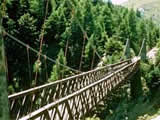What happened that day?
See historic events for any day of the year by entering the date below. Why not try your birthday?
Kiwi of the Week
Today in History

1901 Skippers Bridge opened
At 96 metres long and 90 metres high, the Skippers suspension bridge over the Shotover River near Queenstown in Central Otago is one of the most spectacular bridges in New Zealand. In recent times it has become an iconic tourist destination and one of the world’s premier bungy-jumping sites. Each year thousands of tourists jump from it with a length of elastic rope tied to their ankles – something those who attended its opening in 1901 could never have imagined in their wildest dreams.
Suspended on 14 wire cables, this bridge marked the entrance to the Skippers gold-mining settlement, which was once the largest on the Shotover River. Its opening was celebrated with a ball and banquet, but in many respects it came too late. Miners had already started to abandon the Skippers Canyon area and it ultimately became a bridge to nowhere. The settlement became yet another of the ghost towns that dot the Central Otago landscape.
At the peak of the gold rush some described the Shotover River as the richest river in the world. Thousands were lured to its banks after gold was discovered there in 1862. A precarious pack track was the only access to the Skippers settlement for more than 20 years. Pressure grew for a dray road in the 1880s when quartz mining generated the need to transport heavy machinery to the area. A 3-kilometre stretch of the road involved hand drilling and blasting solid rock to create a road platform nearly 200 metres above the Shotover River. This was no job for the faint hearted and men working on this road had to hang on ropes to complete much of the task. The bridge, with its sheer drop to the Shotover River below, illustrates the difficult conditions encountered by those who sought to seek their fame and fortune in this rugged region.
Image: Skippers bridge (DOC)

1886 Maungatautari Whare Uta (Maori bank) created
The bank was opened in response to Maori concerns that they were being cheated by Pakeha bankers, but it did not prove a success.














